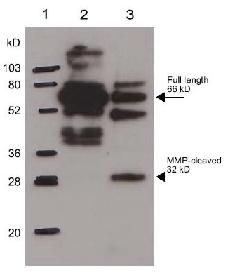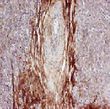Osteopontin (SPP1) Rabbit Polyclonal Antibody
Specifications
| Product Data | |
| Applications | Assay, ELISA, IHC, IP, WB |
| Recommended Dilution | This antibody is suitable for Western blotting, Immunohistochemistry (Formalin Fixed Paraffin-Embedded Sections) and ELISA. A 1/1000 dilution will detect strongly approximately 250 ng of OPN protein on a Blot. No pretreatment is required for Immunohistochemistry when Formalin Fixed Paraffin-Embedded tissue is stained. Recommended Dilutions: ELISA: 1/5,000-1/20,000. Western blot: 1/500-1/2,000. Immunoprecipitation: 1/100. Immunohistochemistry: 1/100-1/300. |
| Reactivities | Canine, Human, Mouse, Porcine, Rat |
| Host | Rabbit |
| Clonality | Polyclonal |
| Immunogen | Synthetic peptide corresponding to Human Osteopontin conjugated to KLH using maleimide. |
| Specificity | This antiserum is directed against Human Osteopontin (OPN). The antibody recognizes the full length osteopontin protein (which runs at 66 kD on westerns), as well as the C-terminal fragments of both thrombin and MMP-cleaved OPN. The 32 kD MMP-cleaved C-fragment is recognized, but not the 40 kD N-terminal fragment. |
| Formulation | 0.02M Potassium Phosphate, 0.15M Sodium Chloride, pH 7.2 State: Serum State: Liquid (sterile filtered) Serum Stabilizer: None Preservative: 0.01% (w/v) Sodium Azide |
| Concentration | lot specific |
| Storage | Store undiluted at 2-8°C for one month or (in aliquots) at -20°C for longer. Avoid repeated freezing and thawing. |
| Stability | Shelf life: one year from despatch. |
| Database Link | |
| Background | Osteopontin (OPN) is an arginine-glycine-aspartic acid (RGD)-containing glycoprotein that interacts with integrins and CD44 as major receptors. OPN is multifunctional, with activities in cell migration, cell survival, inhibition of calcification, regulation of immune cell function, and control of tumor cell phenotype. The gene encoding OPN is called spp1. Targeting this gene has revealed that while OPN is not necessary for normal embryonic development, fertility, and health under pathogen-free conditions, loss of the protein has significant consequences in several models of injury/disease as diverse as renal injury, viral and bacterial infection, bone remodeling, and tumor growth. The fact that no other proteins seem to share a redundant activity with OPN under these conditions suggests that OPN has a unique functional role during tissue injury and stress. Interestingly, several members of the matrix metalloproteinase (MMP) family are also induced during injury/disease processes in patterns overlapping that of OPN. OPN has recently been shown to be a novel substrate for two MMPs, MMP-3 (stromelysin-1) and MMP-7 (matrilysin). There are three cleavage sites for MMP-3 in human OPN, two of which are also cleaved by MMP-7 (see cleavage diagram). Biological assays demonstrate that the MMP-cleaved OPN has increased activity in promoting both cell adhesion and migration compared with full-length OPN. In addition, inhibitory reagents were used to show that the same receptors that interact with OPN also mediate interaction of MMP-cleaved OPN with tumor cells. It is suggested that active forms of OPN at sites of tissue injury may be regulated by the activity of proteases including MMPs and that the differences in activity of modified OPN may be explained by differences in binding affinity of integrins or distinct downstream signaling events. |
| Synonyms | BNSP, OPN, SPP-1, Nephropontin, Uropontin |
| Reference Data | |
Documents
| Product Manuals |
| FAQs |
{0} Product Review(s)
0 Product Review(s)
Submit review
Be the first one to submit a review
Product Citations
*Delivery time may vary from web posted schedule. Occasional delays may occur due to unforeseen
complexities in the preparation of your product. International customers may expect an additional 1-2 weeks
in shipping.






























































































































































































































































 Germany
Germany
 Japan
Japan
 United Kingdom
United Kingdom
 China
China





